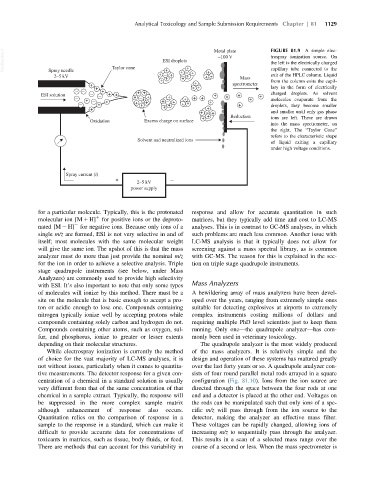Page 1197 - Veterinary Toxicology, Basic and Clinical Principles, 3rd Edition
P. 1197
Analytical Toxicology and Sample Submission Requirements Chapter | 81 1129
VetBooks.ir Taylor cone ESI droplets + Metal plate FIGURE 81.9 A simple elec-
trospray ionization source. On
~100 V
the left is the electrically charged
Spray needle
exit of the HPLC column. Liquid
2–5 kV + – + + + – + + + + + Mass capillary tube connected to the
+ + + from the column exits the capil-
+ + + + spectrometer lary in the form of electrically
– – + +
ESI solution – – + + ++ + + + charged droplets. As solvent
– + – + + + + + + + molecules evaporate from the
+ – + + + + – + +
– + + + + + + + droplets, they become smaller
+ + +
+ – + and smaller until only gas phase
+ + Reduction ions are left. These are drawn
Oxidation Excess charge on surface
into the mass spectrometer, on
the right. The “Taylor Cone”
refers to the characteristic shape
Solvent and neutralized ions
of liquid exiting a capillary
under high voltage conditions.
Spray current (i)
+ 2–5 kV –
power supply
for a particular molecule. Typically, this is the protonated response and allow for accurate quantitation in such
molecular ion [M 1 H] 1 for positive ions or the deproto- matrices, but they typically add time and cost to LC-MS
2
nated [M 2 H] for negative ions. Because only ions of a analyses. This is in contrast to GC-MS analyses, in which
single m/z are formed, ESI is not very selective in and of such problems are much less common. Another issue with
itself; most molecules with the same molecular weight LC-MS analysis is that it typically does not allow for
will give the same ion. The upshot of this is that the mass screening against a mass spectral library, as is common
analyzer must do more than just provide the nominal m/z with GC-MS. The reason for this is explained in the sec-
for the ion in order to achieve a selective analysis. Triple tion on triple stage quadrupole instruments.
stage quadrupole instruments (see below, under Mass
Analyzers) are commonly used to provide high selectivity
with ESI. It’s also important to note that only some types Mass Analyzers
of molecules will ionize by this method. There must be a A bewildering array of mass analyzers have been devel-
site on the molecule that is basic enough to accept a pro- oped over the years, ranging from extremely simple ones
ton or acidic enough to lose one. Compounds containing suitable for detecting explosives at airports to extremely
nitrogen typically ionize well by accepting protons while complex instruments costing millions of dollars and
compounds containing solely carbon and hydrogen do not. requiring multiple PhD level scientists just to keep them
Compounds containing other atoms, such as oxygen, sul- running. Only one—the quadrupole analyzer—has com-
fur, and phosphorus, ionize to greater or lesser extents monly been used in veterinary toxicology.
depending on their molecular structures. The quadrupole analyzer is the most widely produced
While electrospray ionization is currently the method of the mass analyzers. It is relatively simple and the
of choice for the vast majority of LC-MS analyses, it is design and operation of these systems has matured greatly
not without issues, particularly when it comes to quantita- over the last forty years or so. A quadrupole analyzer con-
tive measurements. The detector response for a given con- sists of four round parallel metal rods arrayed in a square
centration of a chemical in a standard solution is usually configuration (Fig. 81.10). Ions from the ion source are
very different from that of the same concentration of that directed through the space between the four rods at one
chemical in a sample extract. Typically, the response will end and a detector is placed at the other end. Voltages on
be suppressed in the more complex sample matrix the rods can be manipulated such that only ions of a spe-
although enhancement of response also occurs. cific m/z will pass through from the ion source to the
Quantitation relies on the comparison of response in a detector, making the analyzer an effective mass filter.
sample to the response in a standard, which can make it These voltages can be rapidly changed, allowing ions of
difficult to provide accurate data for concentrations of increasing m/z to sequentially pass through the analyzer.
toxicants in matrices, such as tissue, body fluids, or feed. This results in a scan of a selected mass range over the
There are methods that can account for this variability in course of a second or less. When the mass spectrometer is

